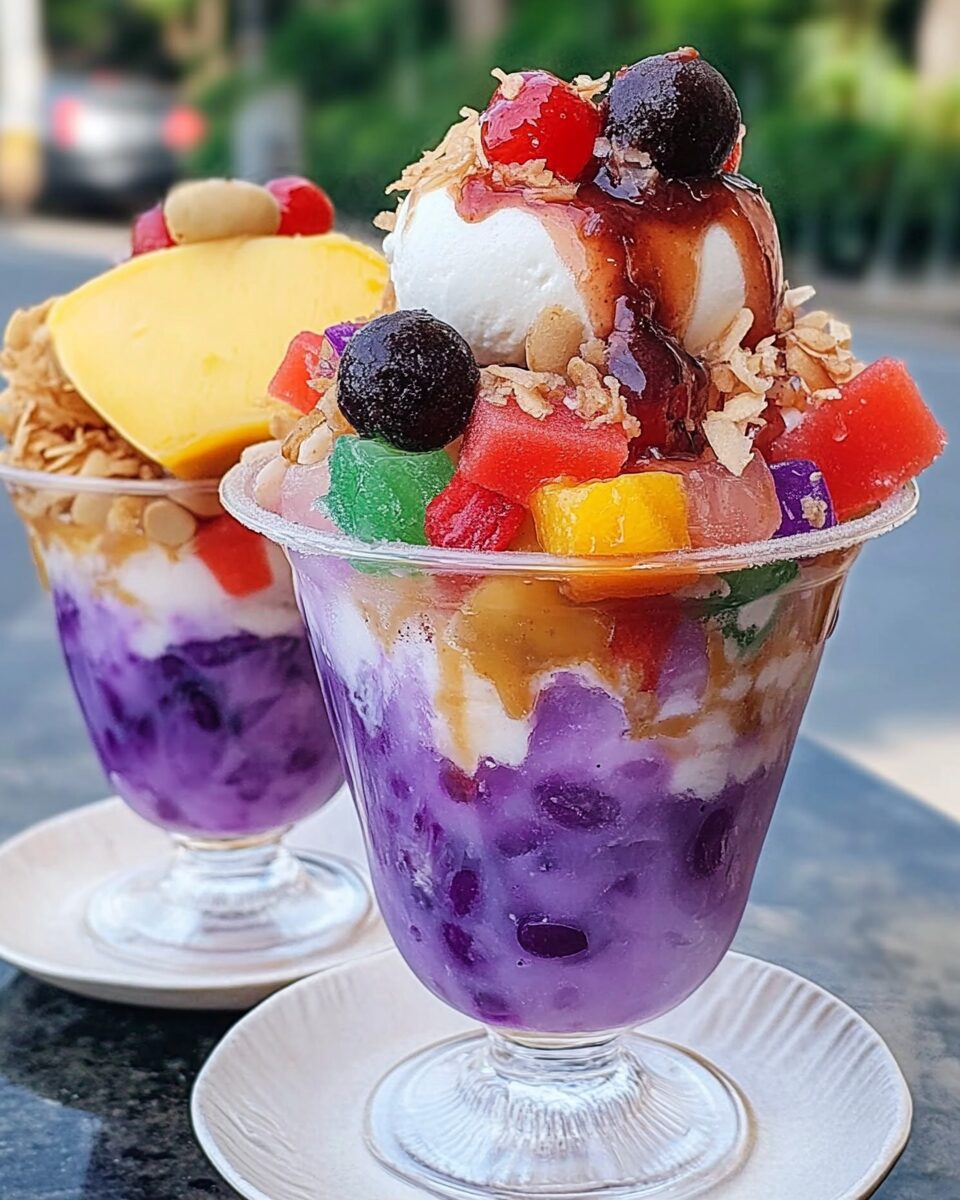A fun and vibrant dessert, the Colorful Halo-Halo Explosion is a delightful mix of sweet, creamy, and crunchy elements. Perfect for hot days, this refreshing treat combines shaved ice with a variety of colorful fruits, jellies, and beans, topped with ice cream for that creamy finish.
FULL RECIPE
Ingredients
- 1 cup shaved ice
- 2 tablespoons sweetened red beans (adzuki beans)
- 2 tablespoons sweetened garbanzo beans
- 2 tablespoons sweetened jackfruit strips
- 2 tablespoons sweetened coconut strips
- 2 tablespoons sweetened nata de coco (coconut gel)
- 2 tablespoons sweetened kaong (sugar palm fruit)
- 2 tablespoons ube jam (purple yam jam)
- 2 scoops vanilla ice cream
- 1 scoop leche flan (caramel custard)
- 1 tablespoon crispy pinipig (crispy rice flakes)
- 1 tablespoon sugar syrup (simple syrup)
Directions
- Prepare a tall glass or dessert bowl.
- Add 2 tablespoons of sweetened red beans at the bottom of the glass.
- Layer with 2 tablespoons of sweetened garbanzo beans and sweetened jackfruit strips.
- Add 2 tablespoons of sweetened coconut strips and nata de coco.
- Pour in 2 tablespoons of sweetened kaong.
- Spoon a generous amount of ube jam over the layered ingredients.
- Add a mound of shaved ice to fill the glass.
- Top with vanilla ice cream and a slice of leche flan.
- Drizzle sugar syrup over the ice and toppings.
- Finish by sprinkling crispy pinipig for extra crunch.
Nutritional Information
- Calories: 350-400 per serving
- Fat: 10g
- Carbohydrates: 65g
- Protein: 4g
- Fiber: 4g
- Sugars: 45g
History of Halo-Halo
Halo-halo, a traditional Filipino dessert, has gained global recognition for its vibrant and unique mix of flavors and textures. Its origins date back to the early 1900s during the period of Japanese influence in the Philippines, where shaved ice desserts became popular. Over time, Filipino vendors added local ingredients, transforming it into a colorful, layered treat that combines a variety of ingredients like sweet beans, fruits, jellies, and ice cream. The name “halo-halo” literally means “mix-mix” in Filipino, which is a fitting description of the dish, as the ingredients are meant to be mixed together before eating.
Variations of Halo-Halo
While the classic halo-halo recipe remains a favorite, variations of this dessert have emerged in different regions of the Philippines and around the world. Some variations might include tropical fruits like mangoes and bananas, while others incorporate different types of sweetened beans or syrups. Each version is a reflection of the local culture and available ingredients. For example, in some areas, halo-halo might be served with a scoop of leche flan, while others use a dollop of ube ice cream, showcasing the versatility of this beloved dessert.
What Makes Halo-Halo Special
Halo-halo stands out because of its combination of textures and flavors. The contrast between the creamy ice cream, the chewy jellies, and the crunchy pinipig gives the dessert an exciting mouthfeel. The mix of sweetened fruits and beans offers a perfect balance of sweetness, while the shaved ice keeps everything cool and refreshing. This balance of textures and flavors makes halo-halo not just a dessert but an experience for the senses.
Popular Ingredients Used in Halo-Halo
One of the key factors that contribute to the success of halo-halo is the wide variety of ingredients that can be used. Common ingredients include sweetened beans, nata de coco, kaong, and various tropical fruits. Ube, a type of purple yam, is often used in desserts in the Philippines and gives halo-halo its signature purple hue. Each ingredient adds its own flavor and texture, creating a complex and satisfying dessert.
The Role of Ice Cream in Halo-Halo
Ice cream plays a crucial role in halo-halo, serving as the creamy topping that brings everything together. Vanilla ice cream is the most common choice, but ube ice cream is also a popular variation. The creaminess of the ice cream contrasts beautifully with the crunchy, chewy, and fruity elements of the dish. The ice cream also adds a smooth richness that balances out the sweetness of the other ingredients.
Cultural Significance of Halo-Halo
Halo-halo is more than just a dessert; it is a symbol of Filipino culture and hospitality. It is often served during festive occasions, family gatherings, and celebrations. The act of mixing the ingredients together is a communal experience, making it a fun and interactive dish for groups to share. Halo-halo is also a representation of the diversity of the Philippines, as it combines ingredients from various cultural influences, reflecting the country’s rich history.
Why Halo-Halo is a Favorite Summer Treat
Halo-halo is especially popular during the hot summer months in the Philippines. The cool, refreshing nature of the dessert makes it the perfect treat to beat the heat. The shaved ice acts as a cooling agent, while the variety of toppings provides an indulgent yet refreshing experience. Whether enjoyed at a street-side stall or as a homemade dessert, halo-halo is the perfect way to cool off during the scorching summer days.
Health Benefits of Halo-Halo Ingredients
Though halo-halo is typically a sugary dessert, some of its ingredients offer nutritional benefits. For example, sweetened beans provide a source of protein and fiber, while tropical fruits like jackfruit and mangoes are rich in vitamins and antioxidants. Additionally, the use of natural ingredients like coconut and palm fruit adds some healthy fats. While halo-halo is a treat that should be enjoyed in moderation, it can be a surprisingly nutrient-dense dessert when prepared with fresh ingredients.
How to Customize Your Halo-Halo
One of the best things about halo-halo is that it can be customized to suit your taste preferences. If you prefer less sweetness, you can adjust the amount of sugar syrup or opt for unsweetened beans. You can also experiment with different types of fruits and jellies or even add other toppings like chocolate syrup or caramel. For a more decadent version, you could even add a drizzle of condensed milk or a sprinkle of toasted coconut flakes.
Serving Suggestions for Halo-Halo
Halo-halo is typically served in tall glasses or dessert bowls, allowing you to layer the ingredients beautifully. For an even more special presentation, consider serving it in a large bowl or sharing platter for a communal experience. You can also garnish the top with additional toppings, such as extra ice cream, sprinkles, or a cherry on top, for a festive touch. The colorful layers not only make it delicious but also visually appealing, making it a great choice for parties and gatherings.
The Art of Mixing Halo-Halo
While it may seem like simply a matter of digging in, the art of eating halo-halo lies in the mixing. After serving, you are encouraged to mix all the ingredients thoroughly, ensuring that every spoonful contains a bit of everything. This is where the fun begins, as you get to experience the contrast of flavors and textures in every bite. The melting ice cream, the soft fruits, the chewy beans, and the crunchy pinipig all blend together, creating a harmonious flavor explosion.
The Importance of Shaved Ice
Shaved ice is an essential component of halo-halo, as it creates a refreshing and light base for the dessert. Unlike crushed ice, which can be uneven and hard, shaved ice provides a fine, snow-like texture that easily melts and integrates with the other ingredients. The shaved ice helps balance out the richness of the ice cream and toppings, making the dessert more refreshing and enjoyable.
Halo-Halo as a Social Experience
Halo-halo is often served as a social dessert, perfect for sharing with friends and family. The experience of mixing the ingredients and enjoying the different textures together makes it an interactive dish. It is common to see halo-halo served at family gatherings, fiestas, and even casual hangouts, as it brings people together to enjoy a delicious and fun treat.
The Influence of Halo-Halo on Filipino Cuisine
Halo-halo has become a symbol of Filipino culinary creativity. It is a representation of how various cultures and influences have come together to create something uniquely Filipino. This dessert is a testament to the Philippines’ rich history of trade and interaction with other countries. From its Japanese-inspired shaved ice to its local Filipino ingredients, halo-halo showcases the country’s diverse culinary heritage.
The Economic Impact of Halo-Halo
Halo-halo is more than just a beloved dessert; it also plays an important role in the Philippine economy. Street vendors and small businesses across the country often sell halo-halo, especially during the summer months, providing a source of income for many. The popularity of halo-halo also encourages the production and sale of various ingredients, such as sweetened beans, fruits, and jellies, contributing to local agriculture and businesses.
How Halo-Halo Fits Into Modern Dining
While halo-halo has deep roots in Filipino tradition, it has also adapted to modern tastes and dining preferences. Many restaurants now serve halo-halo with gourmet twists, using premium ingredients like artisanal ice cream, fresh fruit, and exotic syrups. Some establishments have even elevated halo-halo by presenting it in unique and sophisticated ways, making it a more refined dessert option. Despite these innovations, the essence of halo-halo remains the same: a delightful mix of flavors and textures that satisfy every craving.
The Future of Halo-Halo
As Filipino cuisine continues to grow in popularity around the world, halo-halo is likely to remain a staple dessert. With more people discovering the flavors of Filipino food, halo-halo is gaining a following outside the Philippines. Its adaptability and versatility make it a dish that can evolve with changing culinary trends, ensuring its place in the global food scene for years to come.
Halo-Halo in Pop Culture
Halo-halo has made appearances in various forms of pop culture, from TV shows and movies to food festivals and competitions. Its vibrant colors and unique presentation make it a favorite for food bloggers and influencers, who often share their halo-halo experiences online. The dessert has also become a symbol of Filipino pride, representing the country’s rich culinary traditions and the joy of sharing food with others.
Conclusion
Halo-halo is more than just a dessert; it is a representation of the diverse and rich culture of the Philippines. Its colorful and vibrant mix of ingredients makes it a fun and exciting treat for people of all ages. Whether enjoyed as a refreshing snack on a hot day or as a celebratory dish for special occasions, halo-halo continues to bring people together, offering a delightful and interactive experience. As this beloved dessert continues to evolve and adapt, it remains a delicious symbol of Filipino heritage and creativity.






